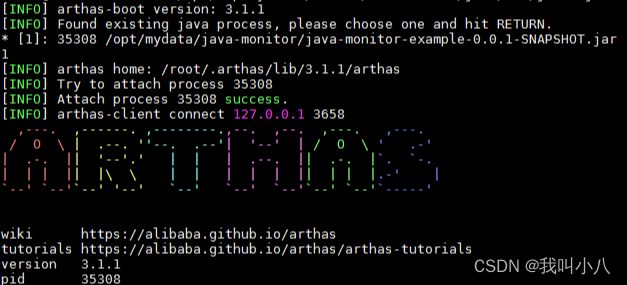引言
它是阿里开源的Java诊断工具,进一步简化了动态追踪技术,有了它,可以直接查看类加载信息、JVM信息、线程堆栈信息、追踪方法执行情况,反编译类文件等,基本涵盖了前面提到的java命令行工具的功能和 BTrace的功能。无需太多额外工作,只需熟悉 Arthas提供的命令即可,很方便。其实 Arthas底层跟 BTrace一样,是基于 jvmAgent方式,使用 Instrumentation方式修改字节码方式然后执行、输出。本文将对 Arthas的使用进行介绍,鉴于官方文档已经写得很详细,建议大家直接阅读官方文档来学习,本文只作抛砖引玉便可。官网地址:https://alibaba.github.io/arthas
Arthas安装与运行
下载Arthas
官方推荐直接下载jar运行
wget https://alibaba.github.io/arthas/arthas-boot.jar
运行Arthas
把下载好的 arthas-boot.jar包放到想要监测的java应用所在服务器,跟 SpringBoot应用一样,直接使用java命令运行即可。
java -jar arthas-boot.jar
注意:
- 第一次运行,下载慢可以使用 --repo-mirror aliyun–use-http
- 启动后,会列出当前的java应用列表(有点像 jps-l),输出序号选择想要监测的应用即可。
启动后即进行 Arthas的命令行界面,可以使用 Arthas提供的命令来实现需要监测的功能。如下图,需要监测的java应用是示例 java-monitor-example。

退出
如果只是退出当前的连接,可以用 quit或者 exit命令。Attach到目标进程上的arthas还会继续运行,端口会保持开放,下次连接时可以直接连接上。
如果想完全退出arthas,可以执行 shutdown命令。
Arthas使用
Arthas的使用就是需要学会使用它提供的命令功能,主要分为几大类:
- 基本命令: help、 cat、 pwd、 history, quit等等,跟linux的命令差不多。
- jvm相关: dashboard、 thread、 jvm、 sysenv等等,主要是对JVM信息的监测,跟之前学习java命令行工具 jinfo、 jmap、 jstack等有异曲同工之妙。
- class/classloader相关: sc、 sm、 jad、 dump、 classloader等等。
- monitor/watch/trace相关: monitor、 watch、 trace、 stack等等,这些功能基本涵盖了 BTrace中所实现的功能,包括定时检测,方法参数,返回值,调用时长等。
下面对常用的几个命令进行说明,详细的命令列表请查阅官方文档。
概览: dashboard
启动 Arthas后, -h查看使用帮助:
$ dashboard -h
USAGE:
dashboard [-b] [-h] [-i <value>] [-n <value>]
SUMMARY:
Overview of target jvm's thread, memory, gc, vm, tomcat info.
EXAMPLES:
dashboard
dashboard -n 10
dashboard -i 2000
相当于概览,在一个界面中显示线程、内存、gc情况,vm情况和tomcat信息。如下图(官方文档的示例图):

这个概览的信息默认5秒刷新一次,对于内存变化,线程占用情况,GC次数,一目了然。使用 ctrl+c退出。
线程信息: thread
还记得 jstack吗,我们需要先找出线程ID,使用它导出线程堆栈,然后使用线程ID查看。在 Arthas中就方便多了,像上面 dashboard中,已经有ID,直接使用 thread id即可。-h查看帮助文档:
$ thread -h
USAGE:
thread [-h] [-b] [-i <value>] [-n <value>] [id]
SUMMARY:
Display thread info, thread stack
EXAMPLES:
thread
thread 51
thread -n -1
thread -n 5
thread -b
thread -i 2000
OPTIONS:
-h, --help this help
-b, --include-blocking-thread Find the thread who is holding a lock that blocks the most number of threads.
-i, --sample-interval <value> Specify the sampling interval (in ms) when calculating cpu usage.
-n, --top-n-threads <value> The number of thread(s) to show, ordered by cpu utilization, -1 to show all.
<id> Show thread stack
如上面所示的 EXAMPLES,使用 thread命令,可以找出占用CPU最高前N个线程( -n),可以打印指定线程的运行堆栈( id),找出当前阻塞其他线程的线程( -b),由此来分析线程问题很方便。
JVM信息: jvm
jvm命令很简单,没有参数,它输出的信息包括运行参数,类加载信息, 内存情况,系统信息,线程数信息,文件描述符等。有点像 jvisualvm的中 概述,但比它更详细。
反编译: jad
有时需要检测线上运行的应用中,新的代码是否有使用或者是否有更新到,可以把加载的类反编译出来,查看源码是否为最新的,这时 jad就很有用。-h打印使用帮助:
$ jad -h
USAGE:
jad [-c <value>] [-h] [-E] [--source-only] class-pattern [method-name]
EXAMPLES:
jad java.lang.String
jad java.lang.String toString
jad --source-only java.lang.String
jad -c 39eb305e org/apache/log4j/Logger
jad -c 39eb305e -E org\\.apache\\.*\\.StringUtils
OPTIONS:
-c, --code <value> The hash code of the special class's classLoader
-h, --help this help
-E, --regex Enable regular expression to match (wildcard matching by default)
--source-only Output source code only
<class-pattern> Class name pattern, use either '.' or '/' as separator
<method-name> method name pattern, decompile a specific method instead of the whole class
如上面所示的 EXAMPLES,jad可以反编译类( class-pattern),反编译类的某个方法( method-name),如果有多个 classLoader,还可以使用 -c来选择显示哪个等。
方法执行监控: monitor
monitor可以定时输出方法的执行情况进行监控,包括调用次数,成功次数,失败次数,平均时长,失败率等,有点像 BTrace中的 @Timer,但是更方便。-h查看使用帮助:
$ monitor -h
USAGE:
monitor [-c <value>] [-h] [-n <value>] [-E] class-pattern method-pattern
SUMMARY:
Monitor method execution statistics, e.g. total/success/failure count, average rt, fail rate, etc.
Examples:
monitor org.apache.commons.lang.StringUtils isBlank
monitor org.apache.commons.lang.StringUtils isBlank -c 5
monitor -E org\.apache\.commons\.lang\.StringUtils isBlank
OPTIONS:
-c, --cycle <value> The monitor interval (in seconds), 60 seconds by default
-h, --help this help
-n, --limits <value> Threshold of execution times
-E, --regex Enable regular expression to match (wildcard matching by default)
<class-pattern> Path and classname of Pattern Matching
<method-pattern> Method of Pattern Matching
如上面所示的 EXAMPLES,可以监测方法执行情况,默认是60s输出一次,可以使用 -c来修改输出间隔时间。
方法执行数据监测: watch
类似于 BTrace的 @OnMethod,若想在线上的应用中把执行方法时的参数,返回值,异常信息, watch命令就非常合适。-h使用帮助:
$ watch -h
USAGE:
watch [-b] [-e] [-x <value>] [-f] [-h] [-n <value>] [-E] [-M <value>] [-s] class-pattern method-pattern express [condition-express]
SUMMARY:
Display the input/output parameter, return object, and thrown exception of specified method invocation
The express may be one of the following expression (evaluated dynamically):
target : the object
clazz : the object's class
method : the constructor or method
params : the parameters array of method
params[0..n] : the element of parameters array
returnObj : the returned object of method
throwExp : the throw exception of method
isReturn : the method ended by return
isThrow : the method ended by throwing exception
#cost : the execution time in ms of method invocation
Examples:
watch -b org.apache.commons.lang.StringUtils isBlank params
watch -f org.apache.commons.lang.StringUtils isBlank returnObj
watch org.apache.commons.lang.StringUtils isBlank '{params, target, returnObj}' -x 2
watch -bf *StringUtils isBlank params
watch *StringUtils isBlank params[0]
watch *StringUtils isBlank params[0] params[0].length==1
watch *StringUtils isBlank params '#cost>100'
watch -E -b org\.apache\.commons\.lang\.StringUtils isBlank params[0]
OPTIONS:
-b, --before Watch before invocation
-e, --exception Watch after throw exception
-x, --expand <value> Expand level of object (1 by default)
-f, --finish Watch after invocation, enable by default
-h, --help this help
-n, --limits <value> Threshold of execution times
-E, --regex Enable regular expression to match (wildcard matching by default)
-M, --sizeLimit <value> Upper size limit in bytes for the result (10 * 1024 * 1024 by default)
-s, --success Watch after successful invocation
<class-pattern> The full qualified class name you want to watch
<method-pattern> The method name you want to watch
<express> the content you want to watch, written by ognl.
Examples:
params
params[0]
'params[0]+params[1]'
'{params[0], target, returnObj}'
returnObj
throwExp
target
clazz
method
如上面所示的 EXAMPLES,监测时机分别是方法执行前( -b),方法执行结束( -f,默认值),方法执行成功( -s)。监测内容包括:参数( params),返回值( returnObj),异常( throwExp)等。
总结
Arthas的强大功能,基本可以对java应用进行全面的监测,是线上应用监测的好帮手,本文相对比较简单地对 Arthas的安装和使用进行入门讲解,抛砖引玉,希望大家能上 Arthas官方网站进一步学习,里面已经对各命令都有详细的讲解和示例,从而让自己的java监测技术更扎实。